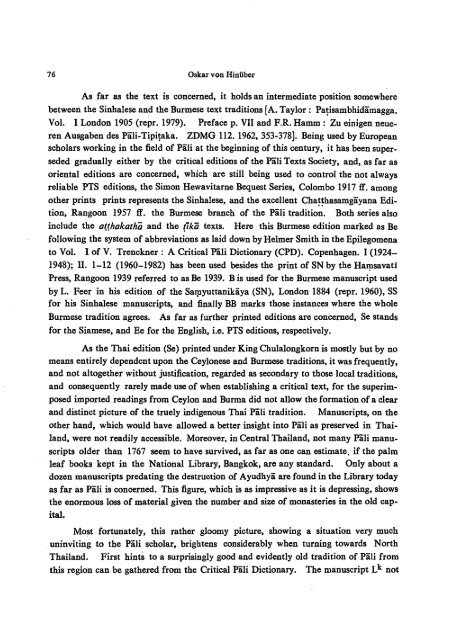The Journal of the Siam Society Vol. LXXI, Part 1-2, 1983 - Khamkoo
The Journal of the Siam Society Vol. LXXI, Part 1-2, 1983 - Khamkoo
The Journal of the Siam Society Vol. LXXI, Part 1-2, 1983 - Khamkoo
Create successful ePaper yourself
Turn your PDF publications into a flip-book with our unique Google optimized e-Paper software.
76 Oskar von Hiniiber<br />
As far as <strong>the</strong> text is concerned, it holds an intermediate position somewhere<br />
between <strong>the</strong> Sinhalese and <strong>the</strong> Burmese text traditions [A. Taylor: Pa~isambhidamagga.·<br />
<strong>Vol</strong>. I London 1905 (repr. 1979). Preface p. VII and P.R. Hamm: Zu einigen neueren<br />
Ausgaben des Pali-Tipi~aka. ZDMG 112. 1962, 353-378]. Being used by European<br />
scholars working in <strong>the</strong> field <strong>of</strong> Pali at <strong>the</strong> beginning <strong>of</strong> this century, it has been superseded<br />
gradually ei<strong>the</strong>r by <strong>the</strong> critical editions <strong>of</strong> <strong>the</strong> Pili Texts <strong>Society</strong>, and, as far as<br />
oriental editions are concerned, which are still being used to control <strong>the</strong> not always<br />
reliable PTS editions, <strong>the</strong> Simon Hewavitarne Bequest Series, Colombo 1917 ff. among<br />
o<strong>the</strong>r prints prints represents <strong>the</strong> Sinhalese, and <strong>the</strong> excellent Cha~~hasa~gayana Edition,<br />
Rangoon 1957 ff. <strong>the</strong> Burmese branch <strong>of</strong> <strong>the</strong> Pali tradition. Both series also<br />
include <strong>the</strong> a(thakatha and <strong>the</strong> !ika texts. Here this Burmese edition marked as Be<br />
following <strong>the</strong> system <strong>of</strong> abbreviations as laid down by Helmer Smith in <strong>the</strong> Epilegomena<br />
to <strong>Vol</strong>. I <strong>of</strong> V. Trenckner: A Critical Piili Dictionary (CPD). Copenhagen. I (1924-<br />
1948); II. 1-12 (1960-1982) has been used besides <strong>the</strong> print <strong>of</strong> SN by <strong>the</strong> Harp.savati<br />
Press, Rangoon 1939 referred to as Be 1939. B is used for <strong>the</strong> Burmese manuscript used<br />
by L. Peer in his edition <strong>of</strong> <strong>the</strong> Satpyuttanikaya (SN), London 1884 (repr. 1960), SS<br />
for his Sinhalese manuscripts, and finally BB marks those instances where <strong>the</strong> whole<br />
Burmese tradition agrees. As far as fur<strong>the</strong>r printed editions are concerned, Se stands<br />
for <strong>the</strong> <strong>Siam</strong>ese, and Ee for <strong>the</strong> English, i.e. PTS editions, respectively.<br />
As <strong>the</strong> Thai edition (Se) printed under King Chulalongkorn is mostly but by no<br />
means entirely dependent upon <strong>the</strong> Ceylonese and Burmese traditions, it was frequently,<br />
and not altoge<strong>the</strong>r without justification, regarded as secondary to those local traditions,<br />
and consequently rarely made use <strong>of</strong> when establishing a critical text, for <strong>the</strong> superimposed<br />
imported readings from Ceylon and Burma did not allow <strong>the</strong> formation <strong>of</strong> a clear<br />
and distinct picture <strong>of</strong> <strong>the</strong> truely indigenous Thai Pali tradition. Manuscripts, on <strong>the</strong><br />
o<strong>the</strong>r hand, which would have allowed a better insight into Pali as preserved in Thailand,<br />
were not readily accessible. Moreover, in Central Thailand, not many Pali manuscripts<br />
older than 1767 seem to have survived, as far as one can estimate, if <strong>the</strong> palm<br />
leaf books kept in <strong>the</strong> National Library, Bangkok, are any standard. Only about a<br />
dozen manuscripts predating <strong>the</strong> destruction <strong>of</strong> Ayudhya are found in <strong>the</strong> Library today<br />
as far as Pali is concerned. This figure, which is as impressive as it is depressing, shows<br />
<strong>the</strong> enormous loss <strong>of</strong> material given <strong>the</strong> number and size <strong>of</strong> monasteries in <strong>the</strong> old capital.<br />
Most fortunately, this ra<strong>the</strong>r gloomy picture, showing a situation very much<br />
uninviting to <strong>the</strong> Pali scholar, brightens considerably when turning towards North<br />
Thailand. First hints to a surprisingly good and evidently old tradition <strong>of</strong> Pali from<br />
this region can be ga<strong>the</strong>red from <strong>the</strong> Critical Piili Dictionary. <strong>The</strong> manuscript Lk not

















